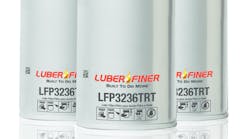All internal combustion engines produce soot as a result of incomplete fuel combustion. However, because of the way that fuel is injected and ignited, soot formation occurs more commonly in diesels than in gasoline engines.
With gasoline engines, the fuel/air mixture is injected during the intake stroke and ignited with a spark, according to officials at Growmark's FS Energy division (www.gofurtherwithfs.com). In diesels, the fuel/air mixture is injected during the compression stroke and ignited spontaneously from the high pressure in the combustion chamber.
Growmark is a regional cooperative providing agriculture-related products and services. FS Energy produces agricultural and energy-related products.
The less air that is present, the more favorable the conditions for soot accumulation, they say. Combustion is more efficient in gasoline engines because the air and fuel have a chance to more thoroughly mix than it typically does in diesel engines.
SOOT ACCUMULATION
When fuel is combusted in the engine, some of the diesel fuel cannot completely combine with oxygen and that leaves behind small unburned particles of carbon, explains Mark Betner, manager of heavy duty lubricant products for Citgo, a refiner, transporter and marketer of transportation fuels, lubricants, petrochemicals and other industrial products. (www.citgo.com). These small carbon particles accumulate in the crankcase oil as the engine piston reciprocates during the engine cycle.
Over time, soot will build up in the oil and may lead to problems, he points out. The soot that accumulates in the oil cannot be eliminated by the oil or completely trapped by the oil filter so keeping the soot under control is the challenge.
Engines that have improper fuel combustion or have malfunctioning fuel injectors can cause additional buildup of soot, he adds. Also, operating conditions, such as excessive engine idling or lugging the engine, can increase the level of soot.
The overall result of these factors, says Betner, is reduced combustion efficiency resulting in higher levels of soot particles forming in the engine oil.
MOVEMENT OF SOOT
In most modern well-maintained diesel engines, the majority of soot will be oxidized within the combustion chamber or later trapped and oxidized downstream in the emissions system, add officials with specialty chemical company Lubrizol Corporation (www.lubrizol.com). However, some soot escapes and gets past the piston rings and ends up in the crankcase oil and soot loading in diesel engine oil can present wear problems.
As the piston goes down for every power stroke, soot can accumulate on the cylinder liners of each bore and can be scraped down by the oil control piston rings, they explain. Soot can be further delivered to the crankcase via blowby of combustion gases past the piston rings, especially if they are worn.
Additionally, the thin motor oil film retained on the bores can partially break down under combustion heat, leaving more soot.
THE CONSEQUENCES
Engine oil is designed with a soot dispersant additive which disperses the soot particles, Citgo's Betner says. Dispersing the soot particles and preventing the natural tendency for the soot particles to join together prevents or at least reduces several lubrication related problems during the engine oil service interval.
There are a number of consequences caused by the buildup of soot in engine oil.
High soot levels in the oil can cause a loss of dispersant additives and ultimately form what is known as sludge, say FE Energy officials. As the dispersants become depleted, the soot particles clump together and attach themselves to engine surfaces. This leads to reduced lubrication due to impeded oil flow through the engine. Particle clumps can also form on oil filters, blocking oil flow and allowing dirty oil into the engine.
Furthermore, soot loading also causes a viscosity increase, which impedes oil flow and increases engine wear leading to premature engine failure, add Lubrizol officials. This is especially the case in cold weather starts where a soot-laden engine oil can increase the time it takes for the oil to reach critical engine parts, such as the valvetrain.
AGGLOMERATION
The tendency for soot particles to aggregate or join together is called agglomeration, explains Betner of Citgo. Soot agglomeration increases when the oil can no longer handle or disperse the level of soot load in the oil.
Soot particles are very small in size and generally pass through the filter media until they begin to agglomerate, he says. At this state, the oil condition can cause several problems:
- Oil thickening or viscosity increase. The accumulation of excessive soot leads to oil thickening which can cause poor oil flow during engine start up and reduce lubrication protection.
- Oil filter plugging. As soot accumulates and begins to agglomerate, the oil filter will collect more soot and eventually reach filtration capacity. Once the oil filter has reached capacity, the engine demands oil either filtered or unfiltered.
The result, Betner says, is that the filter is bypassed to insure the engine gets oil. When this condition occurs, the engine may show a warning signal.
- Higher engine wear. Soot is carbon, and as carbon agglomerates and accumulates it becomes more abrasive. Equipment maintainers who perform oil analysis can see the result of the increased soot loading in several ways. When the percentage of soot in the oil increases, this can result in an oil viscosity increase. If allowed to accumulate to higher levels, the engine wear metals will also increase.
- Increase oil consumption. As oil increases in viscosity due to higher levels of soot loading, there is a tendency for the greater amounts of the thickened oil to accumulate on the engine cylinder wall. As the engine piston moves upward, the increased accumulation of soot laden oil on the cylinder wall may result in the excess oil being released into the combustion process. This condition can result in increased oil consumption.
Some equipment operators have reported increased oil consumption in the later stages of the engine oil service interval, notes Betner. This, in part, can be attributed in some cases to the increased level of soot as the oil service interval increases. Oils that have greater ability to disperse soot tend to reduce the increased oil consumption during these stages of the oil service interval.
MITIGATE THE PROBLEMS
Betner recommends taking the following measures to help mitigate the problems associated with soot loading in the oil:
- Make sure the engine fueling system is maintained properly and the fuel injectors do not cause improper fuel injection.
- Provide operator training for both vehicle operation and observation of engine warning systems.
- Make sure the engine electronic system is properly calibrated and/or updated as needed.
Also consider utilizing a reliable oil analysis program, he adds. A comprehensive oil analysis program, such as the Citgo LubeAlert HD, will show the level of soot, the oil viscosity and the engine wear levels.
Knowing these factors allows equipment maintainers to gain better insight as to the oil condition, the impact of oil change intervals and the overall impact on the engine and filtration system, says Betner.
One more step in ensuring good engine performance is regular preventive maintenance and the use of high-quality engine oils formulated with the latest additive technologies for handling the soot produced in modern engines. Be advised, there are differences in engine oil quality when it comes to handling higher levels of soot.
By way of example, Citgo includes a "very aggressive" Soot Arrest Technology in its premium CITGARD heavy duty engine oils, says Betner. This engine oil technology has been designed to handle the different type of soot produced since the introduction of exhaust gas recirculated engines. These engines produce soot that is more difficult to disperse.





